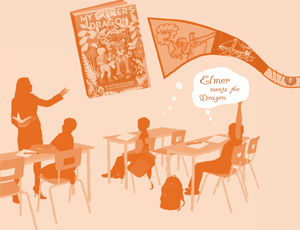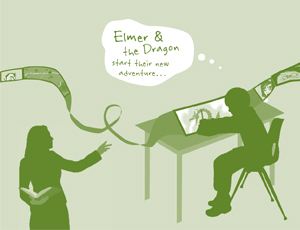Unit 2
Graphic Story Adventures
Purpose
Use the visual art and literary genre of graphic stories to ignite students’ imaginations and motivation to read and write. Students use the strategy of visualization and apply their understanding of story elements to comprehend text and create their own graphic adventures stories.
Unit Description
In this unit, students create a graphic novel sequel to the fantasy adventure My Father’s Dragon, a 1949 Newberry Honor winner by Ruth Stiles Gannett. To prepare, students deeply engage in the literacy strategies and skills of visualization and story elements through guided reading and sketching. Then, students apply their knowledge of the literacy strategies, drawing techniques and graphic story elements to imaginatively create their own sequel to My Father’s Dragon. As a culminating event, the graphic story sequels are published and shared with an invited audience. This unit promotes critically important 21st century skills that include deep understanding and transfer of knowledge and skills in the context of the original text, which students then apply to a new problem or context.
Common Core State Standards
Arts for Learning is aligned with the Common Core State Standards for Reading, Writing, Speaking and Listening, and Language. This Overview describes the scope of the standards and this Quick Reference Guide provides each of the standards fully or partially met within this A4L Unit, followed by the charts that specifically identify the standards addressed in each lesson and step in the Unit. The standards are also coded and listed at the beginning of each lesson in the unit. Arts for Learning also provides a comprehensive student assessment program in each unit. This A4L Assessment Toolkit Quick Reference Chart indicates an overview of the locations of the tasks to be scored in the unit.
Each A4L unit is developed on a common framework and contains a 3-part sequence of instruction that educational research suggests will help students become more self-directed, independent learners. There is a gradual hand-off of responsibility--from teacher to students-- that is supported by assessment and teacher help as needed. Throughout A4L units the arts serve as motive and means to advance reading for meaning and writing thoughtfully.
Purpose
Use the visual art and literary genre of graphic stories to ignite students’ imaginations and motivation to read and write. Students use the strategy of visualization and apply their understanding of story elements to comprehend text and create their own graphic adventures stories.
Unit Description
In this unit, students create a graphic novel sequel to the fantasy adventure My Father’s Dragon, a 1949 Newberry Honor winner by Ruth Stiles Gannett. To prepare, students deeply engage in the literacy strategies and skills of visualization and story elements through guided reading and sketching. Then, students apply their knowledge of the literacy strategies, drawing techniques and graphic story elements to imaginatively create their own sequel to My Father’s Dragon. As a culminating event, the graphic story sequels are published and shared with an invited audience. This unit promotes critically important 21st century skills that include deep understanding and transfer of knowledge and skills in the context of the original text, which students then apply to a new problem or context.
Common Core State Standards
Arts for Learning is aligned with the Common Core State Standards for Reading, Writing, Speaking and Listening, and Language. This Overview describes the scope of the standards and this Quick Reference Guide provides each of the standards fully or partially met within this A4L Unit, followed by the charts that specifically identify the standards addressed in each lesson and step in the Unit. The standards are also coded and listed at the beginning of each lesson in the unit. Arts for Learning also provides a comprehensive student assessment program in each unit. This A4L Assessment Toolkit Quick Reference Chart indicates an overview of the locations of the tasks to be scored in the unit.
Each A4L unit is developed on a common framework and contains a 3-part sequence of instruction that educational research suggests will help students become more self-directed, independent learners. There is a gradual hand-off of responsibility--from teacher to students-- that is supported by assessment and teacher help as needed. Throughout A4L units the arts serve as motive and means to advance reading for meaning and writing thoughtfully.





